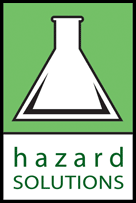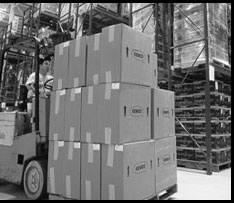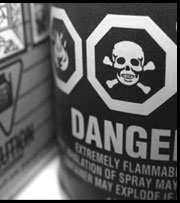Safety Note #2:
• Biotech and Pharmaceutical Options for Onsite Treatment• Identifying Chemicals—Common Naming Systems and Molecular and Structural Formulas
• Bloodborne Pathogens Programs—Don’t Get Stuck by an Incomplete Program
• Hazardous Waste Definition – RCRA and Non-RCRA
by Art Mahoney, M.S., CHMM, REA
June 15, 2005
Biotech and Pharmaceutical Options for Onsite Treatment
You may be able to save money by treating a hazardous waste onsite. Really. In 2002 the California hazardous waste laws changed to allow for onsite neutralization of certain biotechnology and pharmaceutical acidic and caustic wastes without having to first obtain a permit or other authorization. This is a big deal because as many of you know hazardous waste treatment, especially in California, usually requires extensive filing of paper work, payment of fees, etc. To be eligible for this exempt treatment, the waste water must be less than 10 percent by weight acid or caustic (may exceed this percent in some circumstances) and hazardous solely due to the acidic or caustic nature of the waste.
Some waste streams that may be eligible include:
- CIP waste waters
- Dissolution waste waters
- Other acidic and caustic waste waters
For assistance with hazardous waste issues, including waste minimization, onsite treatment options, and onsite assistance, please contact us.
Identifying Chemicals—Common Naming Systems and Molecular and Structural Formulas
As EH&S professionals, we run across hundreds of different chemicals on a weekly if not daily basis. It is part of our job to identify chemicals and determine the rules and regulations which pertain to their safe use and handling. There are a number of systems for identifying chemicals. The most common method of identifying a chemical is by its chemical name. The most commonly used naming system is that developed by the International Union of Pure and Applied Chemistry (IUPAC). Under the IUPAC system, Cu2O is named Copper (I) oxide. Note that the oxidation state of copper is in the parenthesis. [For health and safety professional, oxidation state can make a big difference on whether a chemical is hazardous. For example, Chromium (III) compounds are generally significantly less hazardous than Chromium (VI) compounds]). Under an older naming system, Cu2O is named Cuprous oxide. Another way to identify a chemical is by its Chemical Abstracts Service (CAS) number, which specifies a unique number for each chemical (e.g., CAS number for acetone is 67-64-1). A chemical can also be identified by its molecular formula. For example, the molecular formula of methane is CH4. The molecular formula tells us the atoms which are found in the actual molecule. For methane, it tells us that there is one carbon and four hydrogen atoms in the molecule. Interesting, but does the molecular formula tell us how the atoms are connected (i.e., bonded) to each other? No. Think of all the ways you can connect these five atoms? A structural formula tells us how the atoms are all connected. For methane, the structure formula is given below.
For assistance with chemical safety and handling issues, including EH&S Manager (database for tracking chemical inventories and reporting for HMBP-can now export to Unidocs), please contact us.
Bloodborne Pathogens Programs—Don’t Get Stuck by an Incomplete Program
I recently attended a Cal/OSHA meeting on the topic of establishing regulations to control airborne exposure to pathogens. After the discussion, I asked two of the inspectors what violations of the BBP Standards they most commonly find during their inspections. And this is what they said:
- No written Bloodborne Pathogens Plan. The BBP must be written and accessible to employees. Here is a link to the BBP regulations.
- Training is not occurring annually. Employees with occupational exposure must be retrained annually and there must be an interactive components to the training - video alone is probably not sufficient.
- Employees are not involved in reviewing and updating the plan.
- Used sharps are left unattended.
For assistance with biosafety and bloodborne pathogens plan development and training, please contact us.
Hazardous Waste Definition—RCRA and Non-RCRA
I am assuming that most of you have a good idea what constitutes a hazardous waste. But every so often it is a good idea to refresh our knowledge on the topic, since hazardous waste regulations can be complex. Doing business in California subjects us to two categories of hazardous wastes: RCRA hazardous wastes (i.e., those hazardous wastes regulated nation-wide by the EPA) and non-RCRA hazardous wastes (i.e., those hazardous wastes regulated only in California by the Cal/EPA (or more often than not, a local agency known as a CUPA).
Technically, the first step in determining whether a material is a hazardous waste is to determine if it has been excluded from the legal definition of hazardous waste. To promote recycling and lessen the overall burden to the public and private sectors, certain wastes, such as household hazardous waste, wastes used as feedstock, and many others have been excluded from the definition of hazardous waste.
If you have determined that your waste is not excluded, the next step is to determine if it is meets the definition of a hazardous waste. Let us start with RCRA hazardous wastes. In general, RCRA hazardous wastes include wastes which are listed (because they are generally understood to be hazardous to human health or the environment) and also wastes which exhibit a hazardous characteristic.
Listed RCRA hazardous wastes include the following four categories of wastes:
- F listed wastes – wastes from certain sources, such as solvents.
- K listed wastes – wastes from specific sources, such as distillation bottoms from the production of aniline
- P listed wastes – wastes from expired chemicals or wastes in which the active ingredient is acutely toxic
- U listed wastes- wastes from expired chemicals or wastes in which the active ingredient is toxic
Characteristics of an RCRA hazardous waste include:
- Ignitability (flashpoint < 140F). For example, paint solvents.
- Corrosivity (liquid or gaseous acids and caustic materials. pH < =2 or >=12.5). For example, battery acid or drain certain decloggers. [Note: non-RCRA includes solids as well as liquids]
- Reactivity (chemicals which react violently with water, explosives, and chemicals which emits toxic or flammable gas if mixed with water, contain sulfides or cyanides). For example, cyanide plating waste.
- Toxicity (a waste which fails the Toxicity Characteristic Leaching Procedure (TCLP) test for any of about 40 organic and inorganic chemicals). For example, paint wastes which contain certain toxic metals, such as lead.
Non-RCRA Hazardous Wastes
In California, wastes may be presumed to be hazardous if they are one of approximately 800 pure chemicals or classes of chemicals found in California Code of Regulations, Title 22 Section 66261.126, Appendix X - List of Chemical Names and Common Names for Hazardous Wastes and Hazardous Materials. Included are pure chemicals or classes of compounds (such as silver compounds) as well as types of materials (such as dyes and fuel waste). The burden lies on the back of the waste generator to prove that the waste is not hazardous.
California also has a broader definition of Toxicity. For starters, California has its own leaching test, known as the Waste Extraction Test (WET) test which is different from the TCLP. California has set standards for Soluble Threshold Limit Concentration (STLC) and Total Threshold Limit Concentration (TTLC) for approximately 20 inorganic and 18 organic chemicals or classes of chemicals. California has also set LD50 values for acute oral, acute dermal, and acute inhalation as well as an aquatic 96-hour LC50. Having an LD50 or LC50 below one of these thresholds may mean that you have a non-RCRA hazardous waste.
Hazardous Waste Requirements
Once you have determined that you generate a RCRA or non-RCRA hazardous waste, you are subject to a multitude of regulations that relate to its handling and management. Some of the requirements that may apply, include:
- Containerization and labeling
- Accumulation time limits
- Inspections
- Shipping documents (Manifest)
- Contingency planning
- Biennial reporting
- Waste minimization planning
- Training
- Many more
Please feel free to contact me about other services at 650.347.0417 or e-mail at art@hazardsolutions.com.
Kind Regards and Good Luck
Arthur Mahoney, MS, CHMM, REA



